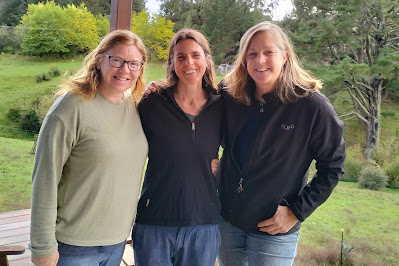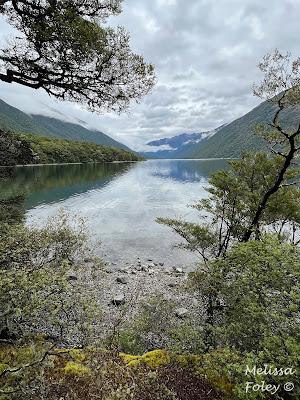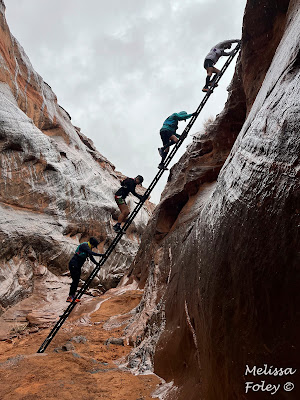Last August, in a moment of questionable judgement, I texted my sister and asked if she wanted to run 50 miles with me in northern Arizona in five months time. If I signed up, this would be my longest run by about 18 miles, but she had run this distance multiple times. I was looking for a bit of a sanity check from her because this was not a distance I was particularly excited about...it seemed far! But the 50k (31 miles) course did not include all of the best features of the course, including the infamous Antelope Canyon, which is not a place you can just rock up to on your own because it is located within the Diné (Navajo) Nation. My sister quickly responded "yes!" so I registered us and panicked a bit after I clicked "submit."
At the time that I signed us up for the trail run I had been running between 40-50 miles a week for a couple of years, so I had a good base. I looked at a lot of training plans and found one that seemed like a good mix of high mileage and rest weeks. For the next five months, I followed that as best I could while working full time, cleaning up from three floods, and losing access to a lot of local trails due to storm damage. I am pretty certain that shoveling mud after all the flooding was a good, albeit unwelcome, addition to my training regime. Having a lofty goal turned out to be a good motivator to stick with the plan even when it was rainy and cold outside. It turns out those training conditions were also fortuitous.
I met my sister in Las Vegas a few days before the run and we started our journey to Arizona by way of St. George, Utah. I did not know it at the time I planned our trip, but St. George is home to UltrAspire, a gear company that hosts my sister as one of their athletes. She contacted them before our arrival and they invited us to come see "where the magic happens." It was really neat to see how the mastermind behind the gear design and owner of the company, Bryce, designs and builds prototypes of all their gear. His passion for and commitment to his trade was inspiring.
Bryce (front), the creative behind UltrAspire
From St. George, we continued east to Page, Arizona, with a brief stop at Pipe Springs National Monument to stretch our legs and get some fresh air. Pipe Springs was a Mormon Outpost and hideout for polygamous wives in the late 1800s and later a stopover for travelers after the property was sold by the Mormon church. The cabins and "castle" still stand and the telegraph line that connected the ranch to Salt Lake City is still wired. The highlight of the site, in my opinion, is the trail around the site that winds through desert scrub with beautiful vistas. The common plants along the trail were identified on small plaques, first using the Paiute name followed by the english, a small nod to the original inhabitants of the land.
We arrived in Page after crossing over the Glen Canyon Dam. The bathtub ring on Lake Powell that was about 150 feet above the water level was a stark reminder of the drought conditions the southwest has been enduring for more than a decade and all of the water issues that plague the Colorado River. I was definitely not in a drought mindset when we arrived because our neighborhood was in danger of flooding for the forth time and I was feeling a bit guilty about leaving Pete to deal with it on his own. Fortunately, we did not flood!
The day before our run was spent packing, checking, and rechecking our drop bags that we would be able to access along the course. I'm really good at making lists and then forgetting to look at them, but I knew I had to be diligent with these precious bags. We also had to get our drop bags to the race crew the morning before our run and wouldn't have a chance to access them again until we were on the course, so there wasn't an option to correct things if we forgot something. We were only preparing two drop bags, but we would access one of them twice. My bags included a wide variety of snacks (you never know what is going to taste good [or not] on a really long run), hydration powder, first aid, clothing, and any other gear I might need along the way, like a portable battery charger for my watch. While the aid stations have lots of snacks, many of them are not an option for me because they often contain gluten and/or dairy, so I had to be sure I could be self sufficient in the food department. The general rule of thumb is to consume 200-250 calories per hour. We were planning on a run time of around 12 hours, so I needed to have at least 2400 calories in my vest and drop bags. The course included a lot of sand, so we also included extra socks and shoes in case we needed a change. The extra socks ended up coming in handy for reasons other than you might expect.
Saturday morning we were up bright and early for a 5:45 am start. We donned our headlamps and were off crossing the desert on our way to the first landmark of the day, Antelope Canyon. Just as we entered the beautiful and winding slot canyon, it started to sprinkle. The forecast for race day was a high in the low 60s, mostly overcast skies, and a 30% chance of rain (half inch or less). In other words, a pretty ideal forecast for a long day of running. That forecast ended up being very far from reality!
looking a little sleepy, but ready to go
entrance to Antelope Canyon
We were not too daunted by the sprinkles at first, but then they became a bit more steady and just kept coming, and the temperature was stalled in the mid-50s. By the time we got to the second landmark, Horseshoe Bend on the Colorado River, the six miles of sandstone between there and the next aid station was a bit more slippery than usual, but we made it without incident.
horseshoe bend, from the Diné side
our route was often very close to the steep canyon walls
(the runner in black is my sister)
The third landmark, Waterhole Canyon, was the first low point of the day. As we neared the slot canyon, we found ourselves standing in a very slow moving line of fellow runners who were waiting to descend the 40-foot ladder into the canyon. It was cold and raining steadily at this point, so standing around for 30 minutes was pretty rough. When we finally got to the front of the line and dropped down into the canyon, large puddles had formed and water was sheeting off the side of the rock walls. When we were part way through the canyon, the race directors stopped allowing people into the canyon because of a flash flood warning. The canyon was beautiful, so at least there was that?!
very long line at the ladder
somewhat sketchy ladder into the slot canyon
there were several ladders inside the canyon, too
official race photo...I just remember being so cold at this point
By the time we got to the aid station at mile 32, we were both wet and cold. Stephie swapped her wet, muddy mittens for a dry pair of sock mittens and I put on my calf sleeves, not because I needed the compression but because I needed the warmth. We drank some hot beverages (hot pickle juice anyone??) and continued onwards. As we started to cross the desert leading to the plateau that Page sits on, the washes that are typically dry had started to fill with water, meaning we had to do a few unplanned water crossings leading to even wetter shoes. As we tried to scramble up the mud-slick hill to the plateau, it became clear that we were not done with obstacles and that mud was in our future.
The soil of the plateau, when wet, is at once slippery and sticky. The trail was a quagmire with more torrents to cross as water sheeted off the plateau in waterfalls. By this time, we were both quite cold and I noticed that my heart rate was around 90. At the time, I thought my watch was being finicky, so I didn't give it much thought. The trail finally got to some better drained soil making for easier running, but the wind was now blowing 15-20 mph. By the time we got to the last aid station of the run, we were both hypothermic but determined to finish. My sister was in worse shape than me, so we got a garbage bag at the aid station, cut a hole in it, and fashioned her a rain poncho. I had a shell on that had stopped being waterproof many miles ago, but it was still providing a bit of warmth. At this point, we had been on the course for 13 hours, so it was starting to get dark and we had 7.5 miles to go. The cutoff time for the run was 15 hours and my sister wanted me to get to the finish line before then, so she urged me to run off ahead of her. I had some trepidation in doing that since she was hypothermic, but she assured me the garbage bag was helping her warm up, so off I went.
mud and waterfalls on the plateau
If this crappy winter did nothing else, it prepared me well for those last miles in the dark, cold, rain, mud, and wind. I was too cold to think about anything else, so I found my groove and crossed the finish line after 14 hours and 30 minutes. Stephie was still out there, though, so I turned around and headed back on the course to find her. At this point, I noticed that my heart rate was down to 60 bpm (while running), so I started to question the sanity of my decision to head back out. Soon I found my sister and we made it to the finish. There was a tent with heaters set up near the finish line, so we made a beeline for that while race volunteers gave us hot food and drinks to help us warm up. We were both so cold that we didn't last long there in favor of getting back to the hotel and hot showers.
we made it!!!
It was a doozy of a first 50-miler for me, and I'm proud that we persevered through all the conditions the day threw at us. The race directors said it was the least accurate forecast they have ever seen for a race. We were not the only ones caught out by the conditions and many people dropped mid-race instead of slogging it out. Fortunately the scenery was beautiful!
We took our time driving back to St. George so we could keep our leg muscles from getting too stiff and sore. We stopped at Marble Canyon to see the condors (success!) and enjoyed one of the many lovely trails in St. George. As always, the best part of this adventure was getting to spend time with my sister doing something we both love.




























































